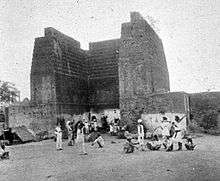Gunfoundry
| Gunfoundry | |
|---|---|
 | |
| Basic information | |
| Location | Hyderabad, India |
| Geographic coordinates | 17°21′41″N 78°28′28″E / 17.36139°N 78.47444°ECoordinates: 17°21′41″N 78°28′28″E / 17.36139°N 78.47444°E |
| Architectural description | |
| Architectural style | Mughal Cannon Architecture |
| Date established | 1786 |
| Specifications | |
| Height (max) | 15 metres (49 ft) |
Gunfoundry also known as Top ka Sancha (1786 AD) was a cannonball factory set up by the second Nizam of Hyderabad, Nawab Mir Nizam Ali Khan at Fateh Maidan in Hyderabad, India. The historic Aliya High School for Boys.
History
Gunfoundry was one of the several cannon and cannonball factories set up in 1786 AD by the French General, Michel Joachim Marie Raymond who was in the service of Nawab Mir Nizam Ali Khan, the second Nizam of Hyderabad. This is the only surviving gunfoundry established in the 18th century, in the Nizams, Hyderabad State.
Building Structure
The original brick walls of Gunfoundry are approximately 50 feet (15 m) high with a tapered portion commencing above 25 feet. Due to poor maintenance, the tapered walls were reduced to 25 to 30 feet. The lower portion was plastered with lime. The shape of the bricks used in the construction of Gunfoundry is square with less thickness. The binding material used is lime mortar. The wall surfaces were covered with lime mortar on the exterior and interior. The walls have joints of square iron rods. In the lower portions, brick arches were made in semi-circular shape, where the smelting was carried out under the supervision of Michel Joachim Marie Raymond.[1]
Authors words
Malcolm's History of India, referred to the foundry in 1798.[1]
The Indian National Trust for Art and Cultural Heritage (INTACH), Hyderabad Chapter, appealed to the then Chief Minister, N. Chandrababu Naidu, to ask the local authorities to remove unauthorised buildings from the vicinity of all protected monuments and notify heritage buildings/precincts.[2]
References
- 1 2 The History Files: Indian Kingdom of Golconda
- ↑ Archived 10 March 2007 at the Wayback Machine.